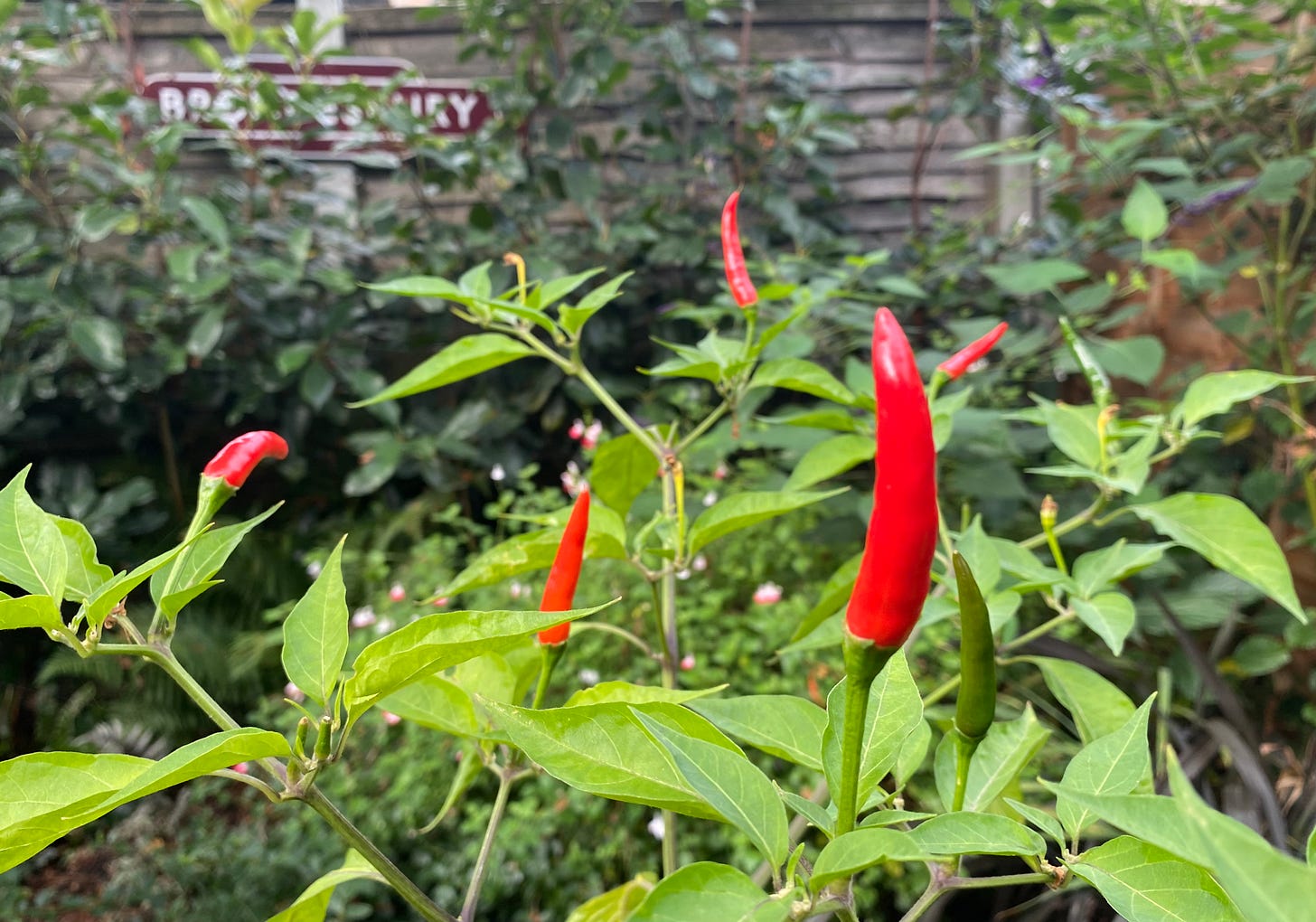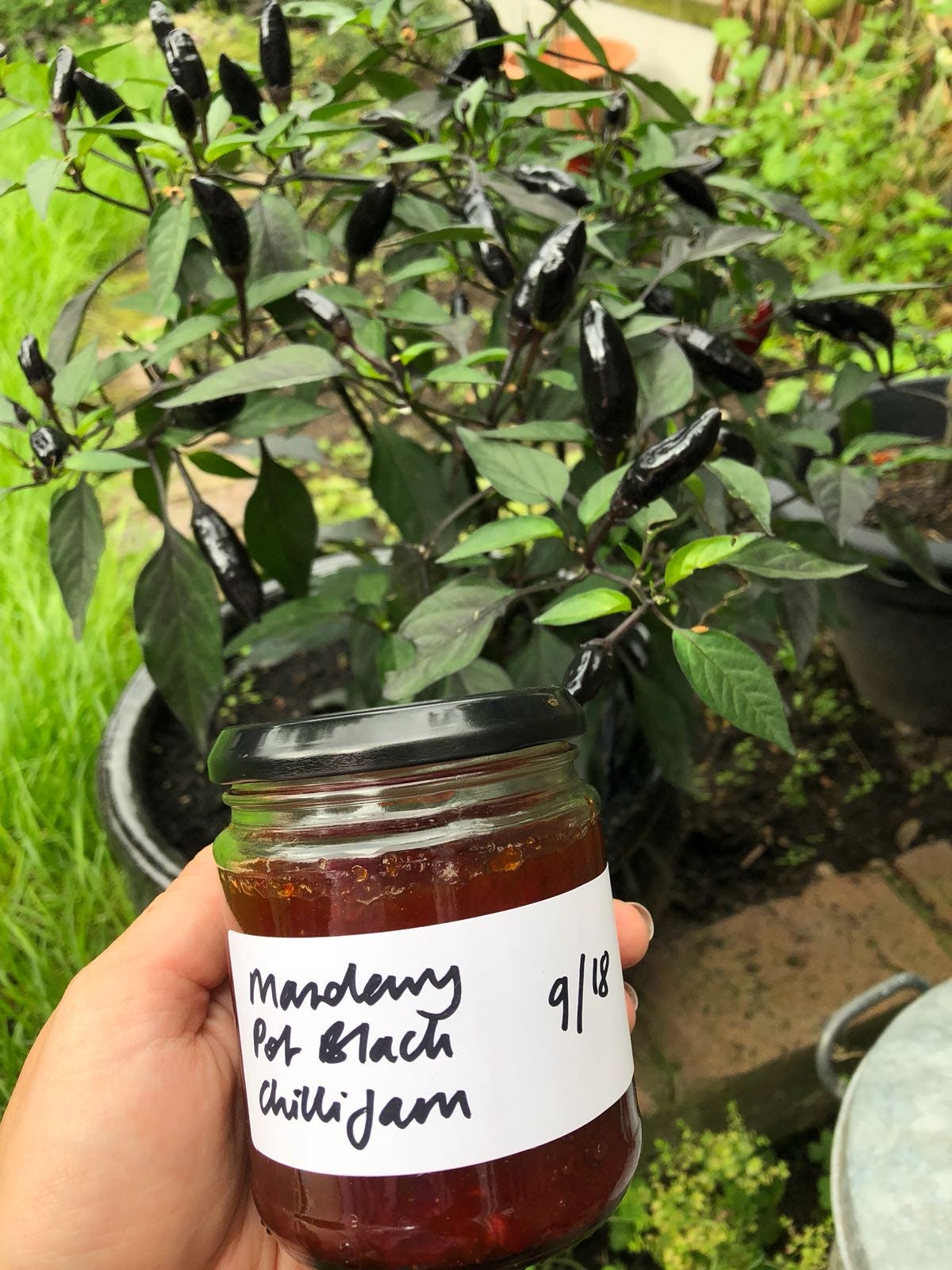Making chilli jam: the condiment of kings
We're jammin' – and I hope you like jammin', too. Featuring the simplest recipe you’ll ever follow
Hello, you’re reading The Earthworm, an alternative gardening newsletter that takes a sideways look at the world of plants. The Earthworm is an independent, reader-supported newsletter. That means no ads, no sponsored content, and no editorial direction from anyone other than yours truly. The two best ways that you can support the work I do is to share this post with a friend, or consider upgrading to a paid subscription (gaining access to exclusive content in the process). Thanks for reading.
I love growing chillies. I’d go so far as to say that, of all the fruit and veg that I have ever grown at home, they are, hands down, my favourite.
The reasons for this are manifold. Firstly: sheer simplicity. As with my tomatoes (which along with aubergines and potatoes belong to the same Nightshade, or Solanaceae family), I tend to buy little plug plants in late spring rather than start them off from seed. Purists would say that that’s somehow cutting a corner, or cheating, but to the purists I say: Bore off.
Once overnight temperatures reliably hit 10ºC, usually around mid-May, the chilli plants come off their perch on a by-now-claustrophobic south-facing windowsill, and find a new, permanent home in the sunniest spot on my patio. Here they will remain until mid-September, when the last of their tongue-tingling fruits has been harvested.
Chillies are delicious, and add a welcome kick to basically any dish. But even if I didn’t enjoy eating chillies, I’d still love growing them. Different varieties cover the whole colour wheel, from the obvious red and green right through to yellow (like the mild banana pepper) and deep purple (‘Pot Black’ is a beautiful, flavourful British-bred cultivar with a perfect mouth-warming heat).
I like to experiment with different varieties from year to year. This summer, I have grown ‘Thai Dragon’ (red and fiery), and ‘Chenzo’ (much more mild, with the main draw being that you can harvest them whilst almost black in colour, though I’ve found them to be too bitter at this stage, and so have allowed them to ripen to red).
Chillies have another unparalleled quality: efficiency. Bang for buck, if you will. Many brassicas, for example, are notoriously bad for this. Take something like a cabbage: each individual plant is enormous, occupying an entirely unjustifiable amount of space in my already over-crowded border, and then, even if I manage to protect the plant through cabbage white caterpillar season, it finally produces one – one! – head of cabbage. Months of growth for one measly side dish.
Not so chillies. Chilli plants tend to be compact. Some particularly petite varieties could even be kept indoors on a windowsill all summer long. They will then produce tons of decorative little fruits, especially if you keep on top of harvesting (which as per deadheading encourages the plant to produce more flowers, and therefore fruit). And unless you like searing the taste buds clean off your tongue with every forkful of food, the chances are you’ll only ever use one or two chillies per meal, so just one plant can go a long, long way.
As such, and unlike any other garden-grown crop, in an average year I will end up with too many chillies. A single side salad would account for most of my annual tomato production; I have never had to give away armfuls of courgettes; but with chillies, I get to experience glut.
There are loads of ways to preserve your excess chillies for future consumption. They apparently dry well, and freeze well too. They can be pickled, or used to create a paste, or a drizzle-it-on-everything oil. But I wouldn’t really know about any of that, because I’ve never done it myself, only experienced the end product as a consumer.
What I do know a little about is this week’s project: chilli jam.
The recipe that my wife and I follow was passed down to us by our friend Zoë’s honorary uncle Paul. We first tasted Uncle Paul’s legendary “Pound Chilli Jam” (named after his home, not the value or weight of the jam) at Zoë’s house, and were blown away by the beautifully balanced, sweet, spicy, fruity flavour. We immediately asked for the recipe – which was generously shared – and were delighted by its lack of complexity.
I mean, no offence to Uncle Paul, but it is so straightforward that it can barely be classed as a recipe. There are four ingredients: chillies, red bell peppers, distilled white vinegar, and sugar. Obviously, Uncle Paul is able to mix up a batch of farmer’s market-quality chilli jam without the need for such trifling paraphernalia as a measuring jug or a set of scales, but if like me you take comfort in precision, then you will need the following:
10 chillies
10 red bell peppers
1kg sugar
500ml distilled white vinegar
You can fiddle around with these quantities, depending on whether you like your jam more sweet or savoury; the only real “rule” is to use equal parts spicy peppers to mild. (Clearly, you can dial up the heat by using greater quantities of your chosen chilli, or opting for a spicier variety.) De-seed the chillies (or not, if you like it hot), and blend up all of your peppers in a food processor. Finally, throw this peppery mush into a large pan along with the sugar and vinegar, and warm it up over a low-ish heat, stirring regularly until the liquid reaches ”jamming point”.
This is the only part of the process that requires any degree of competence in the kitchen. As such, it is the only part of the process that has resulted in my previously producing an inedible cement, rather than a gorgeously gooey condiment.
To check if your jam is ready, spoon some onto a cold plate and tilt the plate vertically. If the jam oozes down the plate like bubbling, molten lava, it is ready. If the mixture cascades down the plate like a pyroclastic flow, it is not. If it doesn’t budge at all, you have ruined it. Good luck.
In my experience, this recipe produces enough jam to keep my household well stocked in spicy sandwich sauce for the coming year, whilst also providing some thoughtful Christmas/Chanukah gifts for a handful of lucky loved ones. We’re talking 8-10 small jars. Small, but powerfully tasty.
Now if you’ll excuse me, I’m needed in the kitchen. Happy jamming.
Have you ever made chilli jam, or chilli oil, or chilli anything else? If so, I would LOVE to hear about it. Please do share your experiences and/or favourite recipes in the comments!
Starting from next week (6th September), these midweek posts will be fully visible to paid subscribers only. Upgrade now so you don’t miss a thing.








Sounds delicious! How do you think this would work with raw honey rather than sugar?
Sounds delicious! Although I think my garden follows different rules than your garden - I’ve never had much luck with peppers. Each pepper plant usually produces just a couple fruit while my tomatoes and courgettes go crazy until I’m making regular veg deliveries to all the neighbors by mid-summer. I took a break from peppers this summer but maybe I’ll give them another go next year!